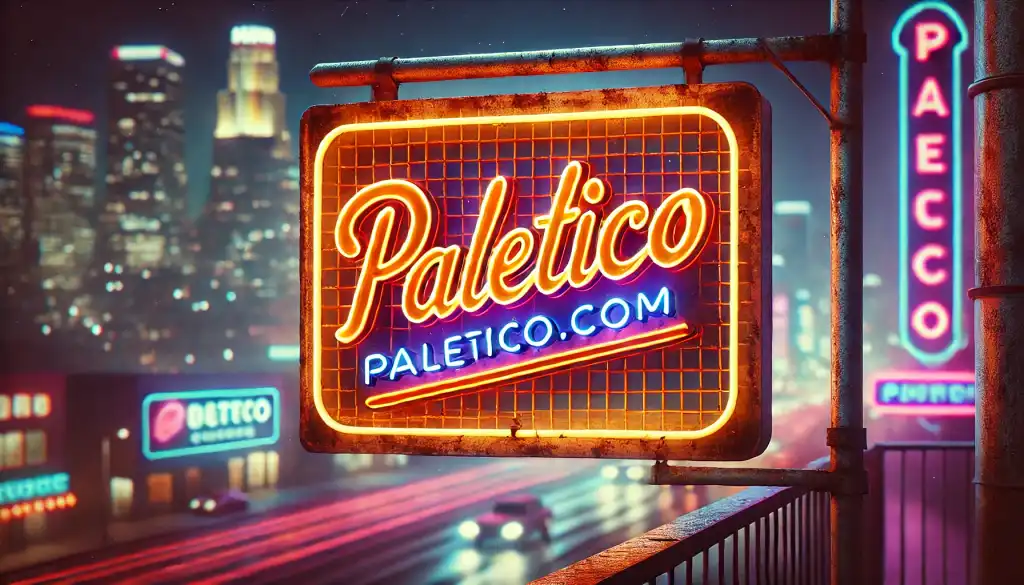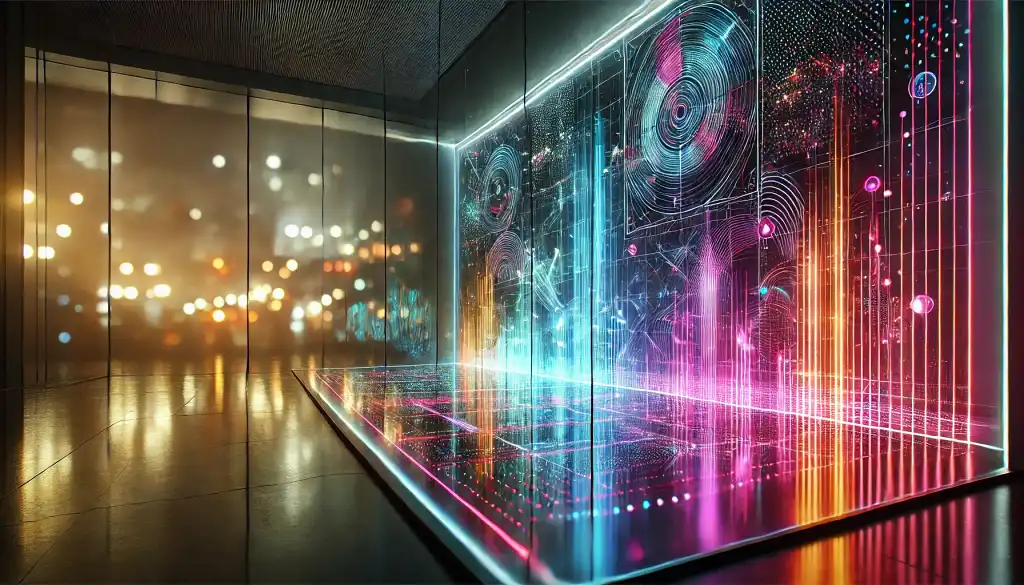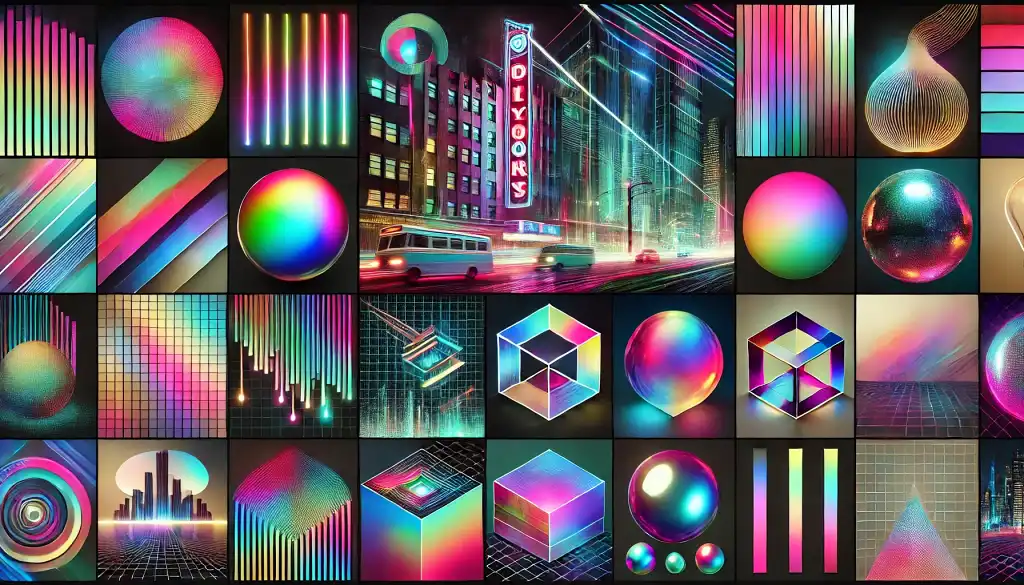In the heart of the digital age, colors are no longer confined to the natural world; they have taken on a life of their own. Neon lights pulse in electric hues across cityscapes, gradients flow seamlessly in digital designs, and metallic reflections glint like the future itself. These modern color connections, bold and captivating, reflect the essence of our time—an era where technology and creativity collide to push boundaries and redefine aesthetics.
Imagine the glow of neon pinks and greens casting an otherworldly light over a bustling urban street, where every reflection and shadow becomes part of the spectacle. Picture the fluid, dreamlike gradients that grace our digital screens, moving from deep purples to electric blues, evoking the intangible beauty of light itself. Then shift your gaze to the reflective brilliance of metal—shimmering silver, liquid chrome, and holographic gold—all of which capture the modern fascination with innovation and luxury.
These color palettes are not just visual experiences; they are emotional triggers. Neons embody energy, immediacy, and the electricity of urban life. Gradients evoke fluidity, harmony, and the infinite possibilities of the digital realm. Metallic tones ground us in strength and resilience while hinting at the opulence of a high-tech future. Together, they create a language of color that speaks directly to our collective imagination.
At the core of these modern connections lies the intersection of light and material. From the sleek facades of futuristic skyscrapers reflecting the city’s glow to the vivid colors of augmented reality blending into our physical spaces, these combinations challenge our perception of what’s real and what’s possible. They blur the boundaries between nature and technology, creating a dynamic interplay that defines the aesthetic of the 21st century.
This journey through modern colors invites you to explore the abstract and unexpected. It celebrates the vibrancy of neon, the elegance of gradients, and the shimmering sophistication of metallic tones. As we move through these realms, we discover not just how colors look, but how they feel—and how they inspire us to reimagine the world around us.
The Power of Neon: Energy and Expression in Color
Neon is the heartbeat of modern design, pulsating with energy and commanding attention wherever it appears. It is bold, unapologetic, and alive—its vibrant glow transforming even the most ordinary spaces into electric dreamscapes. Born from the interplay of gas and light, neon has evolved from nostalgic diner signs to a symbol of futuristic urban landscapes and digital creativity.
In the city, neon thrives. Picture a bustling street at night, where fluorescent pinks, radiant greens, and electric blues spill over every surface, reflecting in rain-slicked pavement and glassy skyscrapers. The city itself becomes an immersive work of art, its architecture bathed in colors that seem to hum with life. This is the language of neon: intense, immediate, and visceral.

But neon isn’t confined to physical spaces—it dominates digital landscapes, too. In the world of UX design and gaming, neon hues bring interfaces and virtual realms to life. From glowing health bars in video games to vibrant hover effects on websites, these colors draw users in, creating a sense of movement and engagement. They mirror the speed and energy of the digital age, where light and color are as much a part of the experience as the functionality itself.
Neon also thrives in abstraction, particularly in contemporary art and fashion. Designers embrace these vivid hues to challenge traditional color norms, pairing neon pink with lime green or turquoise with blazing orange. These bold choices exude confidence, defy expectations, and demand to be noticed.
Yet, the power of neon isn’t just in its vibrancy—it’s in its emotional resonance. Neon pink ignites feelings of excitement and playfulness, while neon blue evokes curiosity and wonder. Lime green can feel both futuristic and organic, a balance that reflects the duality of technology and nature.
As we look closer, neon becomes more than just a color. It is a symbol of movement, progress, and a world in constant evolution. Whether lighting up a street, enhancing a digital experience, or setting a daring tone in fashion, neon’s glow reminds us that creativity thrives in boldness.
Color Palette:
The Elegance of Gradients: Fluid Harmony in Digital and Physical Realms
Gradients are the essence of modern fluidity—a visual language that seamlessly merges bold colors into mesmerizing transitions. Unlike static hues, gradients evoke movement, depth, and emotion, making them a staple in both digital and physical spaces. They are not just a trend but a testament to how technology can elevate color into an art form.
Imagine a twilight sky where deep purples fade into vibrant magentas, blending effortlessly into warm oranges. This natural gradient, often captured in photographs, inspires countless digital designs—from the glowing interfaces of mobile apps to the hypnotic backgrounds of social media stories. Gradients represent evolution and possibility, capturing the essence of modern life’s dynamism.

In the world of web and app design, gradients have redefined user experiences. They create layers of depth in flat designs, guiding the eye with smooth transitions that feel intuitive and immersive. Think of the subtle transition of a loading bar that shifts from cool teal to bright pink, building anticipation while maintaining visual harmony. In gaming, gradients breathe life into fantastical worlds, painting skies and landscapes that feel both surreal and inviting.
But gradients are not confined to screens. In fashion and architecture, their influence is equally profound. Holographic fabrics shimmer with shifting hues, moving from blues to purples with every step. Futuristic buildings, like mirrored prisms, reflect gradients of the city around them, creating a living interplay of light and color. These physical gradients remind us of the connection between the digital and tangible worlds, where one inspires and enhances the other.
Gradients also evoke emotions:
- Cool blues transitioning to purples convey calm and introspection.
- Vibrant magentas blending into oranges evoke energy and creativity.
- Soft pastels merging into deeper shades bring balance and nostalgia.
The elegance of gradients lies in their ability to be both dynamic and soothing, futuristic and timeless. They are a bridge between art and technology, proof that beauty often lies in transition.
Color Palette:
Metallic Reflections: Strength, Luxury, and the Glow of Innovation
Metallic tones are the embodiment of modern sophistication, blending sleekness with a futuristic edge. From the gleam of polished chrome to the shimmer of holographic gold, these colors evoke a sense of strength, luxury, and technological advancement. Metallics don’t just reflect light—they reflect the spirit of innovation.
Picture a towering skyscraper with a facade of mirrored silver, standing tall against a backdrop of deep blue skies. As the sun moves across the horizon, the building becomes a living artwork, its surface capturing and transforming the light into ever-changing gradients of steel gray, platinum, and gold. This dynamic interplay of light and reflection is the hallmark of metallic hues—they are never static, always alive.
In fashion, metallics add a touch of boldness and opulence. A futuristic gown with shimmering silver threads or a pair of iridescent gold sneakers creates a statement of confidence and modernity. Meanwhile, interior design incorporates metallics to achieve balance, using brass, copper, and steel to accentuate minimalistic spaces and create a dialogue between warmth and industrial coolness.

The influence of metallics extends to the digital world, where holographic effects dominate design trends. Think of app interfaces with subtle metallic gradients or futuristic branding that incorporates shimmering textures to catch the eye. These designs leverage metallic tones to suggest quality, reliability, and forward-thinking aesthetics.
Emotionally, metallics evoke a unique combination of feelings. Silver and steel tones communicate resilience and clarity, while gold and bronze carry undertones of prestige and success. Holographic effects, on the other hand, inspire curiosity and a sense of wonder, reflecting the limitless possibilities of technology and creativity.
Metallic reflections aren’t just colors—they’re experiences. They symbolize the fusion of the tangible and intangible, the real and the imagined. In a world increasingly shaped by technology, these tones remind us that beauty can be found in the balance between strength and elegance, simplicity and complexity.
Color Palette:
The Dynamic Play of Light and Color
Light transforms color. It brings it to life, changes its tone, and redefines its impact. In modern design and art, the interplay of light and color has become a powerful tool to captivate and inspire. From installations that shift hues with every passing second to environments where lighting dynamically alters the perception of space, this marriage of light and color is a celebration of innovation.
The Power of Changing Light
Imagine standing in front of a massive art installation: a translucent wall illuminated by programmable LEDs. With each passing moment, the wall shifts from deep indigo to vibrant magenta, then to a glowing cyan. The colors don’t just exist—they move, evolve, and interact, creating an emotional dialogue with the viewer. This is the essence of dynamic light: it transforms static spaces into living experiences.
Natural light, too, plays its part. At dawn, the soft golden rays of the sun can make pastel walls glow with warmth, while at dusk, shadows deepen the intensity of blues and purples. Artists and designers increasingly incorporate this natural dynamism, creating environments that change with the light of day.
Urban Landscapes and Interactive Installations
Cities are becoming stages for light and color to perform. Neon lights flicker across wet streets, their reflections creating pools of electric energy. Interactive light shows, like those seen at festivals such as Sydney’s Vivid or Lyon’s Fête des Lumières, bring entire urban landscapes to life, blending architecture with immersive art.
A particularly stunning example is the Harpa Concert Hall in Reykjavík, Iceland. Its glass facade is illuminated by a constantly shifting array of colored lights, mimicking the aurora borealis. It’s a building that doesn’t just sit in its environment—it becomes part of it, reflecting the natural wonder of the Icelandic sky.
Light in Digital Realms
In the digital world, light-inspired gradients and effects mimic the subtleties of physical light. These digital designs often blend neon and metallic hues, using shadow and glow to add dimension. Gaming and virtual reality environments take this interplay further, immersing players in worlds where light reacts dynamically to their movements.

Colors Shaped by Light: A Palette
Illuminating the Future
As technology evolves, the interplay of light and color will become even more dynamic. Imagine environments where lighting adapts to mood, creating spaces that are as responsive as they are beautiful. The future is luminous, vibrant, and alive with the endless possibilities of light and color.
Colors in Motion: Dynamic Designs That Energize
Color takes on a new dimension when paired with motion, creating a sensory experience that captures attention and evokes emotion. Whether it’s the glowing trails of light in a bustling cityscape or the seamless animations of digital interfaces, dynamic color transforms the static into the spectacular. In motion, colors breathe—they expand, evolve, and interact, creating an ever-changing narrative.
Urban Colors in Motion
Imagine a vibrant city at night, alive with movement and color. Neon lights pulse rhythmically, casting their hues onto passing cars and pedestrians. Reflections ripple in puddles, blending pinks, greens, and blues into an abstract, kinetic painting. High-speed trains streak through tunnels, leaving glowing trails of red and white, while billboards flash gradients and animations designed to dazzle.
This energy is the lifeblood of urban spaces, where color and motion combine to create an environment that feels alive. Installations like Tokyo’s Shibuya Crossing—where synchronized lights, moving advertisements, and glowing traffic signals converge—are perfect examples of how motion amplifies color’s impact.
Digital Motion: Animations and Interfaces
In the digital world, motion unlocks new possibilities for color. Interactive interfaces use gradients that shift as users navigate, creating a dynamic flow that feels intuitive and engaging. Buttons light up when hovered over, changing from soft pastels to vibrant hues. Animated backgrounds simulate the shimmer of light, adding depth and texture to otherwise flat designs.
Video games and VR experiences take motion even further, immersing players in environments where the movement of light and color responds to their actions. Imagine stepping into a virtual sunset where the sky evolves from warm orange to deep purple as you explore, or a futuristic cityscape where glowing trails guide your way through neon-lit streets.
Emotional Impact of Colors in Motion
When colors are in motion, they evoke stronger emotional responses.
- Pulsing neon pinks and greens energize, creating excitement and urgency.
- Smooth transitions of blues and purples calm and focus the mind.
- Vibrant bursts of gold and red feel celebratory and powerful.
These combinations, whether in urban spaces or digital realms, captivate by tapping into our instinctive reactions to light and movement.

Color Palette:
Holographic Colors: The Art of Shimmer and Shift
Holographic colors are a marvel of light and material interaction, creating surfaces that appear alive with ever-changing hues. These colors, often described as “liquid rainbows,” shift and shimmer depending on the angle of light, offering a visual experience that feels both futuristic and magical.
The Science of the Spectacle
Holographic colors are more than just visually striking; they are a result of advanced technology. Microscopic structures in materials refract light, splitting it into its spectral components. This creates the mesmerizing effect of a surface that appears to “change” colors as you move around it. These colors symbolize innovation, blending science with aesthetic brilliance.
Where Holographic Colors Shine
Holographic effects have found their way into every corner of modern design:
- Fashion: Iridescent fabrics that catch the light, creating fluid shifts between pinks, greens, and silvers. Think futuristic sneakers or accessories that make a bold, modern statement.
- Tech Products: Gadgets with holographic finishes, from smartphone cases to laptops, combining utility with high-tech allure.
- Packaging Design: Cosmetic and luxury goods often feature holographic elements to create an irresistible, premium appeal.
- Art Installations: Walls or sculptures with holographic finishes that react dynamically to light, engaging viewers in an immersive experience.
Emotional Resonance of Holographics
Holographic colors evoke a unique emotional response. They feel fluid, dynamic, and otherworldly, inspiring curiosity and wonder. Their shimmering, prismatic quality reminds us of the intersection between the real and the imagined—a hallmark of futuristic aesthetics.

Color Palette:
The Infinite Potential of Modern Colors
Modern colors are not just tools of expression—they are experiences that evoke emotion, challenge perception, and redefine creativity. From the bold vibrancy of neon lights energizing urban landscapes to the soft fluidity of gradients shaping digital interfaces, colors have become an integral part of how we connect with the world around us. Holographic effects and metallic reflections push boundaries even further, blending technology and art into something truly futuristic.
These colors do more than catch the eye; they tell stories of innovation and transformation. They remind us of the dynamic interplay between light, motion, and material, showing how creativity knows no bounds in the modern era. Whether in cityscapes, digital platforms, or physical designs, the spectrum of possibilities continues to expand, inspiring us to see the world—and ourselves—through a brighter, more vibrant lens.
As we journey deeper into the age of technology and design, one thing is clear: the future of color is as limitless as our imagination.
